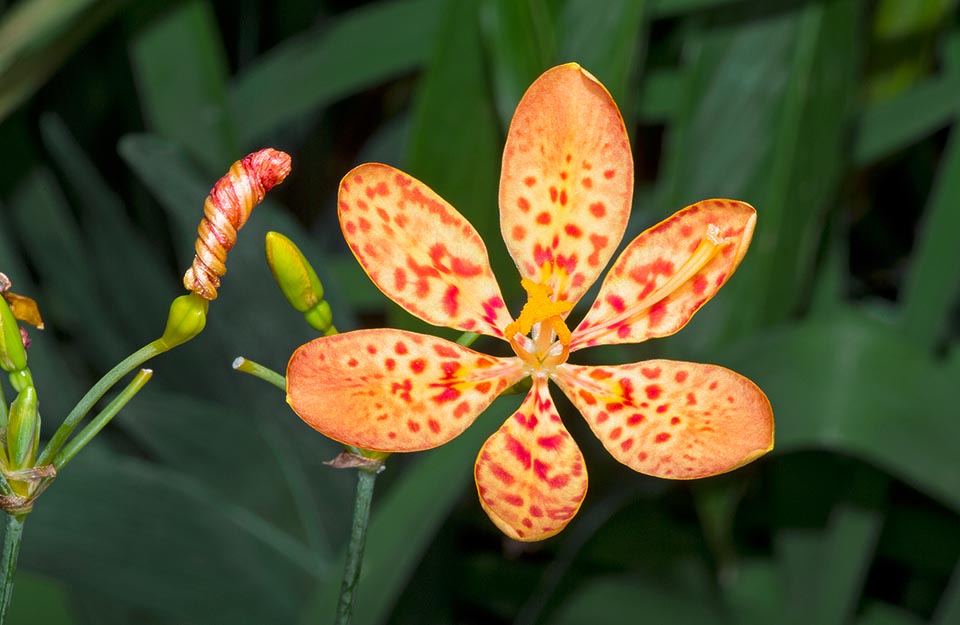Family : Iridaceae

Text © Pietro Puccio

English translation by Mario Beltramini
The species is native to Bangladesh, China (Anhui, Fujian, Gansu, Guangdong, Guangxi, Guizhou, Hainan, Hebei, Heilongjiang, Henan, Hubei, Hunan, Jiangsu, Jiangxi, Jilin, Liaoning, Ningxia, Shaanxi, Shandong, Shanxi, Sichuan, Xizang, Yunnan and Zhejiang), Korea, Himalaya, India, Japan, Malaysia, Myanmar, Nepal, Philippines, Russia (Primorye), Taiwan and Vietnam where it lives in the meadows, woody clearings and rocky outcrops, often near water streams, from the sea level up to about 2000 m of altitude.
The name of the genus is that of messenger of the gods in the Greek mythology, coming from “ἷρις” (iris) = rainbow; the specific name is the Latin adjective “domesticus, a, um” = domestic, homely.
Common names: blackberry-lily, leopard flower (English); she gan (Chinese); iris tigré, fleur de léopard, pardanthe de Chine (French); abanico (Tagalog).
The Iris domestica (L.) Goldblatt & Mabb. (2005) is a perennial herbaceous species with fairly short life, 0,3-1 m tall, with fleshy creeping rhizome, ramified, of 1-2 cm of diameter, and erect stem with 8-12 alternate leaves, distichous, imbricate at the base, lanceolate with pointed apex, 20-35 cm long and 3-5 cm broad, of glaucous green colour. Ramified terminal inflorescences, up to about 1,2 m tall, with several hermaphroditic flowers, of 4-5 cm of diameter, with 6 elliptic-obovate tepals of orange yellow to orange red colour with irregular dark red spots, 3 stamina, about 2 cm long, and style with triparted stigma; the flowers last one day only, but open gradually for various weeks. Several varieties have been selected among which one of uniform bright yellow colour. The fruits are ovoid capsules, 2,5-3 cm long and of 1,5-2,5 cm of diameter, containing globose seeds, of 0,5 cm of diameter, of glossy black colour that remain visible on the plant for long time after the opening of the capsule; it easily auto-disseminates.

Frequent in tropical gardens, the Iris domestica resists even to -15 °C. The 4-5 cm broad flowers last only one day but open gradually for various weeks. All parts of the plant are poisonous, the rhizomes are used in the traditional medicine and nowadays laboratory studies have shown interesting bioactive compounds © Giuseppe Mazza
It reproduces by seed in fertile soil, draining, maintained lightly humid, with germination times of 2-3 weeks and first blooming on the first year, or by division in spring, with each section provided of at least one bud, taking care to dry up the cut for 1-2 days before planting. It is better to frequently renew the plant in order to have vigourous and floriferous tufts.
Much ornamental and of easy cultivation rhizomatous, utilizable in an ample variety of climates, from the tropical to the continental one, where it can resist to temperatures up to about -15 °C if well mulched, as isolated group or for edgings, even mixed. It requires full sun or light shade and well drained soils, not bearing water stagnations, even if poor, slightly acidic to slightly alkaline, but grow best in the rich ones, frequently fertilized and with good availability of water, though it can well stand dry periods. Cultivable successfully in pot for the decoration of patios, balconies and terraces. All parts of the plant are poisonous if ingested, the rhizomes since remote times are utilized in the traditional medicine, particularly in the Chinese one, for various pathologies. Laboratory studies have found in the plant several bioactive compounds with interesting properties likely to be further studied. The dry infructescences, long lasting, are utilized in the floral compositions.
Synonyms: Epidendrum domesticum L. (1753); Ixia chinensis L. (1753); Moraea chinensis (L.) Thunb. (1783); Ixia ensifolia Noronha (1790); Belamcanda punctata Moench (1794); Ferraria crocea Salisb. (1796); Pardanthus chinensis (L.) Ker Gawl. (1804); Belamcanda chinensis (L.) DC. (1805); Moraea chinensis (L.) Collander in Thunb. (1809); Bermudiana guttata Stokes (1812); Pardanthus nepalensis Sweet (1826); Moraea guttata (Stokes) Stokes (1830); Pardanthus sinensis Van Houtte (1865); Gemmingia chinensis (L.) Kuntze (1891); Belamcanda pampaninii H.Lév. (1910); Vanilla domestica (L.) Druce (1914); Belamcanda chinensis var. curtata Makino (1917); Belamcanda chinensis f. flava Makino (1917); Belamcanda chinensis f. vulgaris Makino (1917); Belamcanda flabellata Grey (1934); Gemmingia chinensis f. aureoflora Makino (1940); Gemmingia chinensis f. rubriflora Makino (1940); Belamcanda chinensis var. taiwanensis S.S.Ying (1980).
→ To appreciate the biodiversity within the IRIDACEAE family please click here.
